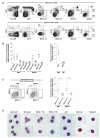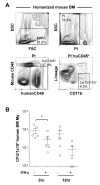Development of mature and functional human myeloid subsets in hematopoietic stem cell-engrafted NOD/SCID/IL2rγKO mice
- PMID: 22611244
- PMCID: PMC3370073
- DOI: 10.4049/jimmunol.1103660
Development of mature and functional human myeloid subsets in hematopoietic stem cell-engrafted NOD/SCID/IL2rγKO mice
Abstract
Although physiological development of human lymphoid subsets has become well documented in humanized mice, in vivo development of human myeloid subsets in a xenotransplantation setting has remained unevaluated. Therefore, we investigated in vivo differentiation and function of human myeloid subsets in NOD/SCID/IL2rγ(null) (NSG) mouse recipients transplanted with purified lineage(-)CD34(+)CD38(-) cord blood hematopoietic stem cells. At 4-6 mo posttransplantation, we identified the development of human neutrophils, basophils, mast cells, monocytes, and conventional and plasmacytoid dendritic cells in the recipient hematopoietic organs. The tissue distribution and morphology of these human myeloid cells were similar to those identified in humans. After cytokine stimulation in vitro, phosphorylation of STAT molecules was observed in neutrophils and monocytes. In vivo administration of human G-CSF resulted in the recruitment of human myeloid cells into the recipient circulation. Flow cytometry and confocal imaging demonstrated that human bone marrow monocytes and alveolar macrophages in the recipients displayed intact phagocytic function. Human bone marrow-derived monocytes/macrophages were further confirmed to exhibit phagocytosis and killing of Salmonella typhimurium upon IFN-γ stimulation. These findings demonstrate the development of mature and functionally intact human myeloid subsets in vivo in the NSG recipients. In vivo human myelopoiesis established in the NSG humanized mouse system may facilitate the investigation of human myeloid cell biology including in vivo analyses of infectious diseases and therapeutic interventions.
Figures







Similar articles
-
Human lymphoid and myeloid cell development in NOD/LtSz-scid IL2R gamma null mice engrafted with mobilized human hemopoietic stem cells.J Immunol. 2005 May 15;174(10):6477-89. doi: 10.4049/jimmunol.174.10.6477. J Immunol. 2005. PMID: 15879151
-
Long-term human CD34+ stem cell-engrafted nonobese diabetic/SCID/IL-2R gamma(null) mice show impaired CD8+ T cell maintenance and a functional arrest of immature NK cells.J Immunol. 2010 Sep 1;185(5):2710-20. doi: 10.4049/jimmunol.1000583. Epub 2010 Jul 28. J Immunol. 2010. PMID: 20668220
-
Development of functional human blood and immune systems in NOD/SCID/IL2 receptor {gamma} chain(null) mice.Blood. 2005 Sep 1;106(5):1565-73. doi: 10.1182/blood-2005-02-0516. Epub 2005 May 26. Blood. 2005. PMID: 15920010 Free PMC article.
-
Modeling normal and malignant human hematopoiesis in vivo through newborn NSG xenotransplantation.Int J Hematol. 2013 Dec;98(6):634-40. doi: 10.1007/s12185-013-1467-9. Epub 2013 Nov 21. Int J Hematol. 2013. PMID: 24258713 Review.
-
A Monocytic Barrier to the Humanization of Immunodeficient Mice.Curr Stem Cell Res Ther. 2024;19(7):959-980. doi: 10.2174/011574888X263597231001164351. Curr Stem Cell Res Ther. 2024. PMID: 37859310 Free PMC article. Review.
Cited by
-
Development of a new humanized mouse model to study acute inflammatory arthritis.J Transl Med. 2012 Sep 13;10:190. doi: 10.1186/1479-5876-10-190. J Transl Med. 2012. PMID: 22974474 Free PMC article.
-
Generation of Immunodeficient Mice Bearing Human Immune Systems by the Engraftment of Hematopoietic Stem Cells.Methods Mol Biol. 2016;1438:67-78. doi: 10.1007/978-1-4939-3661-8_4. Methods Mol Biol. 2016. PMID: 27150084 Free PMC article.
-
A novel mouse model for stable engraftment of a human immune system and human hepatocytes.PLoS One. 2015 Mar 17;10(3):e0119820. doi: 10.1371/journal.pone.0119820. eCollection 2015. PLoS One. 2015. PMID: 25782010 Free PMC article.
-
Development of human innate immune responses in a humanized mouse model expressing four human myelopoiesis transgenes.Front Immunol. 2024 Sep 27;15:1419117. doi: 10.3389/fimmu.2024.1419117. eCollection 2024. Front Immunol. 2024. PMID: 39399507 Free PMC article.
-
Cell-Extrinsic MHC Class I Molecule Engagement Augments Human NK Cell Education Programmed by Cell-Intrinsic MHC Class I.Immunity. 2016 Aug 16;45(2):280-91. doi: 10.1016/j.immuni.2016.07.005. Epub 2016 Aug 2. Immunity. 2016. PMID: 27496730 Free PMC article.
References
-
- Mosier DE, Gulizia RJ, Baird SM, Wilson DB. Transfer of a functional human immune system to mice with severe combined immunodeficiency. Nature. 1988;335:256–259. - PubMed
-
- McCune JM, Namikawa R, Kaneshima H, Shultz LD, Lieberman M, Weissman IL. The SCID-hu mouse: murine model for the analysis of human hematolymphoid differentiation and function. Science. 1988;241:1632–1639. - PubMed
-
- Greiner DL, Hesselton RA, Shultz LD. SCID mouse models of human stem cell engraftment. Stem Cells. 1998;16:166–177. - PubMed
-
- Shultz LD, Schweitzer PA, Christianson SW, Gott B, Schweitzer IB, Tennent B, McKenna S, Mobraaten L, Rajan TV, Greiner DL, et al. Multiple defects in innate and adaptive immunologic function in NOD/LtSz-scid mice. J Immunol. 1995;154:180–191. - PubMed
-
- Takenaka K, Prasolava TK, Wang JC, Mortin-Toth SM, Khalouei S, Gan OI, Dick JE, Danska JS. Polymorphism in Sirpa modulates engraftment of human hematopoietic stem cells. Nature Immunology. 2007;8:1313–1323. - PubMed
Publication types
MeSH terms
Substances
Grants and funding
LinkOut - more resources
Full Text Sources
Other Literature Sources
Molecular Biology Databases
Research Materials

